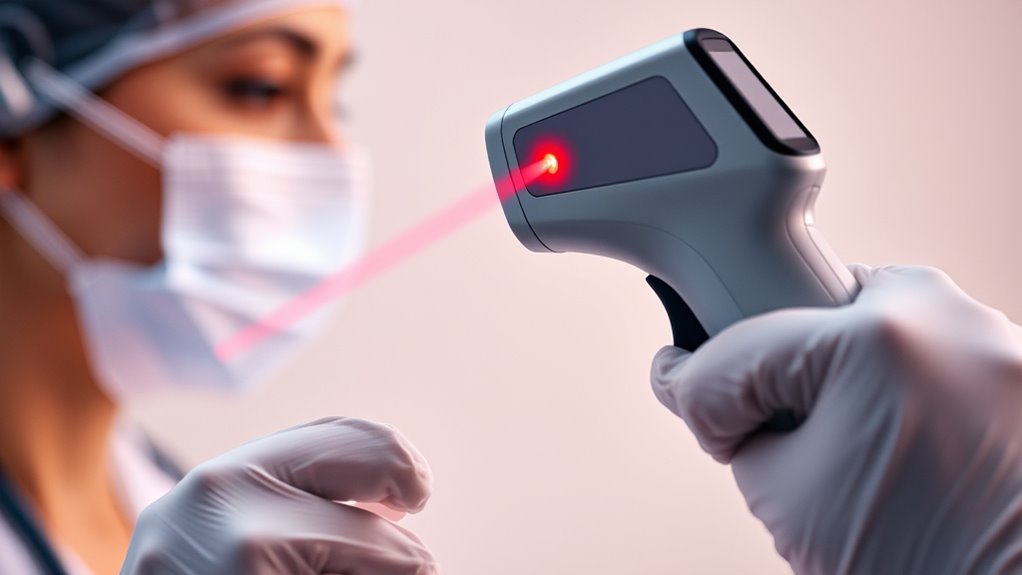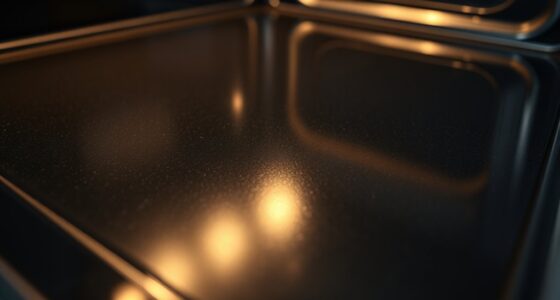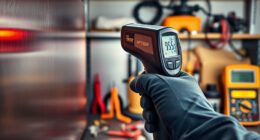To avoid laser hazards when using infrared thermometers, always keep the laser beam away from your eyes and others’. Never stare directly into the laser or point it at anyone. Check that safety features are functioning and maintain proper calibration to make certain of accuracy and safety. Handle the device carefully, keep it clean, and avoid reflections from shiny surfaces. If you follow these precautions, you can use your thermometer safely and effectively. More tips await if you keep exploring.
Key Takeaways
- Never point the laser directly into eyes; always keep the beam away from the eye’s line of sight.
- Regularly verify laser alignment and safety features before use to ensure proper operation.
- Follow manufacturer instructions for calibration and maintenance to prevent laser misalignment.
- Use the thermometer in appropriate environments, avoiding reflective surfaces and direct sunlight.
- Handle and store the device properly to prevent damage that could compromise laser safety.

Have you ever wondered if infrared thermometers are safe to use? It’s a common concern, especially since these devices emit laser beams to measure temperature. While infrared thermometers are generally safe when used correctly, understanding laser safety is essential to prevent potential hazards. The laser component in these thermometers is classified as a Class 2 or Class 3R laser, which means it can cause minor eye injuries if directly stared into for extended periods. To guarantee safety, always avoid pointing the laser directly into your eyes or those of others. Most devices come with built-in safety features, but it’s your responsibility to use them properly. Keeping the laser beam away from the eye’s line of sight minimizes the risk of accidental exposure.
Proper calibration is another critical aspect of safe infrared thermometer use. Over time, these devices can drift from their original accuracy, leading to incorrect readings and potential misjudgments, especially in medical or industrial settings. Regular calibration ensures that your thermometer provides precise temperature measurements, reducing the likelihood of errors that could compromise safety or decision-making. Many manufacturers recommend periodic calibration checks, which can often be performed with standard calibration sources or by professional services. Always follow the manufacturer’s instructions regarding calibration intervals and procedures. Proper calibration not only guarantees accuracy but also helps in maintaining the device’s safety features, including laser alignment. Misaligned lasers could pose additional risks, so verifying that the laser points accurately and consistently during calibration is crucial.
Additionally, authorized calibration services can ensure your device remains within safety standards and provides reliable readings. When using an infrared thermometer, you should also be mindful of your environment. Ensure that the device is clean and free of dust or smudges, which can interfere with the laser’s accuracy and safety. Avoid using the thermometer in direct sunlight or in highly reflective surroundings, as these conditions can cause erroneous readings or unintended laser reflections. Always read the user manual thoroughly to understand the specific safety precautions related to your model. Proper handling and maintenance extend the lifespan of your device and keep it operating securely.
Frequently Asked Questions
Can Infrared Thermometers Be Used on Reflective Surfaces Safely?
You can use infrared thermometers on reflective surfaces, but you need to be cautious. Reflective surface challenges can cause inaccurate readings due to laser reflection. Always follow laser safety precautions, such as avoiding direct eye exposure and keeping the device at the proper distance. Use a non-reflective cover or indirect measurement methods when possible to guarantee safety and accuracy. Stay vigilant to prevent laser hazards and obtain reliable temperature readings.
Are There Age Restrictions for Using Infrared Thermometers?
You should verify the manufacturer’s safety guidelines for age restrictions, as they vary between models. Typically, infrared thermometers are safe for older children and adults, but young children or infants might require supervision or alternative methods. Always follow safety guidelines to ensure proper use and avoid laser hazards, especially with children around. If in doubt, consult the product instructions and consider professional advice to keep everyone safe.
How Long Can I Continuously Use an Infrared Thermometer?
You can typically use an infrared thermometer continuously for about 10 to 20 seconds. Prolonged usage beyond this can lead to device overheating, which may affect accuracy or damage the device. To guarantee safe and effective measurements, avoid extended usage and give the device a brief rest if you need to take multiple readings. Always follow manufacturer guidelines for ideal usage duration and to prevent overheating issues.
Do Infrared Thermometers Emit Any Harmful Radiation?
Imagine you’re using an infrared thermometer to check a patient’s fever. These devices do not emit harmful radiation like X-rays or UV rays. They use laser safety features for aiming, but the laser itself isn’t harmful if used properly. You won’t experience radiation exposure, making infrared thermometers safe for routine use. Just guarantee you follow instructions, avoid direct eye contact with the laser, and understand that the device’s emissions are non-ionizing and safe.
Can Infrared Thermometers Be Used for Medical Purposes on Infants?
You can use infrared thermometers for infant safety, but make certain they’re specifically designed for medical use. These thermometers provide quick, accurate readings, helping you monitor your infant’s temperature without discomfort. Always follow the manufacturer’s instructions to maintain thermometer accuracy and prevent any risk. Avoid using non-medical infrared devices, as they may not offer reliable results or ensure the safety needed for infants.
Conclusion
By following these safety tips, you’ll turn your infrared thermometer into a harmless superhero, not a laser-powered villain. Imagine a tiny beam of light so powerful it could cut through steel—scary, right? But with proper use, you’ll keep that beam safely contained, sparing your eyes and skin from disaster. Think of yourself as the protector of your household, wielding a harmless gadget that’s more friend than foe. Stay cautious, stay safe, and keep those lasers in check!









